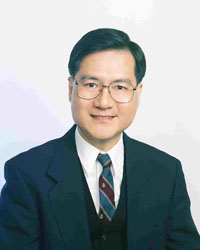江簡富 Jean-Fu Kiang
台大教職員工文康活動推行委員會主任委員(2005-)
台大研發處創新育成組組長(2005-2008)
台大創新育成中心主任(2005-2008)
Chairman, Commission on Faculty and Staff Extracurricular Activities (2005-)
Director, Division of Innovation and Incubation, Office of Research and Development (2005-2008)
Director, NTU Innovation Incubation Center (2005-2008)
主要研究領域:
電磁應用與系統: 電波傳播、天線及陣列、雷達訊號處理、遙測模擬。Major Research Areas:
Electromagnetic applications and systems: wave propagation, antennas and arrays, radar signal processing, remote-sensing simulations.研究領域摘要:
電磁應用與系統: 電波傳播、天線及陣列、雷達訊號處理、遙測模擬。
Research Summary:
Jean-Fu (Jeff) Kiang has been guiding his students to apply different ideas, theories and methods in exploration of various electromagnetic phenomena and possible applications. Recent endeavors include how to merge multiple modes in a dielectric resonator antenna to increase its bandwidth (2007- 2009); how a tsunami wave perturbs the ionosphere and affects the GPS signals, leading to a method to detect a tsunami within 15 minutes of occurrence (2009); how to design 3D miniaturized broadband antennas with size of λ/10 (2010, 2011); how to improve the accuracy of a differential GPS system to within a few cm at a distance of 100 km from the reference station, leading to one possible application to measure the real-time wind field within a typhoon (2011); how to optimize a large phased array with tens of thousands of antenna elements by using evolutionary algorithms (2013-2015); how to reconstruct a better image of a celestial object 60 million light-years from the Earth, based on very-long baseline interferometry (2014); how to design super-lenses with meta-materials to achieve a resolution of λ/30 (2014); how to simulate wave propagation in the lower atmosphere, considering the effects of refractivity profile inversion and turbulence, under different weather conditions (2014); how to model the synchronization among an array of coupled oscillators originally operating at different frequencies (2014, 2015); how to reconstruct high-fidelity microwave images of multiple underground objects (2014, 2015); how to simulate wave scattering by a very large rough surface (2015); how to compensate for the coupling among antennas in an array to improve the direction-of-arrival estimation to within 0.1 degree, even from directions far away from normal incidence (2015); how to evaluate the impact on ground objects from a high-altitude electromagnetic pulse (2016); how to estimate the parameters of an evolving sand-and-dust storm using improved radar equations (2016); how to apply LEO-ground infrared laser occultation technique and a harmony search algorithm to retrieve major greenhouse gas profiles around a specific receiver site in nearly real time (2017); how to apply synthetic- aperture radar (SAR) imaging on ground objects at high squint angles (2017); how to compensate motion errors in SAR imaging (2017); how to apply microwave hyperthermia to treat cancers (2018, 2019); how to process radar signals to estimate direction-of-arrival (DOA) and carrier frequency of multiple signal sources with co-primed array and triply-primed array techniques (2018, 2019); how to compute the brightness temperatures from very lossy medium by using finite-difference time-domain (FDTD) method to obtain near-field bistatic transmission coefficients and by extending the Planck's law to lossy medium (2019).
Documents of these works and other interesting explorations can be viewed at the website:
http://cc.ee.ntu.edu.tw/~jfkiang/selected_publications.html

-
B.S.
National Taiwan University, 1979 -
Ph.D.
Massachusetts Institute of Technology, 1989
-
Address
EE2-208,
Department of Electrical Engineering,
National Taiwan University,
Taipei 106, Taiwan -
Phone
+886-2-33663661 -
FAX
+886-2-2368-3824 -
Email:

-
Office Hour
Please make appointment by e-mail or phone call. -
Personal Homepage
http://cc.ee.ntu.edu.tw/~jfkiang/